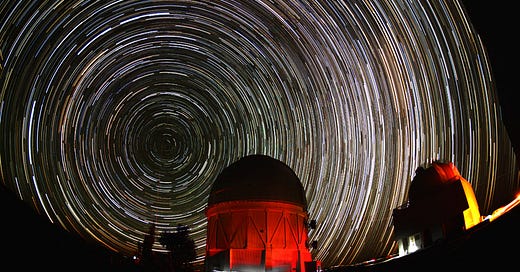"An Exit Chute from the Universe to the Reality of Galactic Empires"
Another week of wild news from the Cosmos, ranging from the Physics of DNA to amazing (and perhaps terrifying) discoveries that lie buried in NASA Mission(s) data.
Quantum Astronomy Could Create Telescopes Hundreds of Kilometers Wide --Astronomers hope to use innovations from the subatomic world to construct breathtakingly large arrays of optical observatories, reports Anil Ananthaswamy for Scientific American.
Could We Force the Universe to Crash? --If we’re all living in a simulation, as some have suggested, it would be a good, albeit risky, way to find out for sure, reports Caleb Scharf for Scientific American. "The proposition that the world is a sham is not new; it’s been cropping up for thousands of years across different cultures, from China to ancient Greece, advocated by thinkers like Descartes with his mind-body dualism. But this more recent version, based around computation—or at least artificial reconstruction—bubbled up around 2003 with the publication of a paper titled “Are You Living in a Computer Simulation?” by the philosopher Nick Bostrom"
“The Radio Species” –Scientists Doubt ‘Human Niche’ Would Be Filled If We Go Extinct, reports The Daily Galaxy. --"For what purpose did the human brain evolve is a question that has puzzled scientists for decades. In 2010 Colin Blakemore, an Oxford neurobiologist argued that a mutation in the brain of a single human being 200,000 years ago turned intellectually able primates into a super-intelligent species that would conquer the world. Homo sapiens appears to be a genetic accident."
A Wrinkle in Nature Could Lead to Alien Life--There may be more than one way to tune a universe for life, reports Caleb Scharf for Nautil.us. "Our fairytale concepts of “galactic empires” could be woefully too conservative. We may need to more fully embrace the fact that the prospects and rules for life in the universe have not always been the same, and almost certainly won’t be the same in the future."
Physics of DNA –“In Each of Us Lies a Message, Its Beginnings Lost in the Mists of Time”, reports The Daily Galaxy. "As we’ve moved into the information age, we’ve come to realize that life is more about information than energy. Fire has most of the characteristics of life. It eats, it grows, it reproduces. But fire retains no information. It doesn’t learn; it doesn’t adapt. The five millionth fire started by lightning will behave just like the first. But the five hundredth bacterial division will not be like the first one, especially if there is environmental pressure. That’s DNA. And RNA. That’s life.”
Cosmic Map of Ultrahigh-Energy Particles Points to Long-Hidden Treasures --Ultrahigh-energy cosmic rays twist and turn on their way to Earth, which has made it nearly impossible to identify the colossal monsters that create them, reports Natalie Wolchover for Quanta.
An Exit Chute from the Universe: The Story of a Historic Effort to Image a Black Hole --After more than a decade of effort, a global network of radio telescopes revealed the first-ever picture of an enigmatic hole in spacetime, reports Seth Fletcher for Scientific American.
“The Unknown” –What Amazing Discoveries Lie Buried in NASA Mission Data? asks The Daily Galaxy --"Is evidence of a twin Earth buried in unexamined Kepler Mission data? Kepler’s last observing campaign, Campaign 19, started on August 29, 2018 after the spacecraft’s configuration had been modified in 2014 in order to adapt to a change in thruster performance, and NASA officially changed the mission’s name from Kepler to K2 while using the same telescope. During the following 27 days, Kepler observed more than 30,000 stars in the constellation of Aquarius. The stars included dozens of known and suspected exoplanet systems — including the well-known TRAPPIST-1 system with its seven Earth-sized planets."
Astronomers Observe Nearby Galaxy with Two Bright Cores, reports SciNews. “This friendly-looking object is the result of two galaxies — known as Mrk 739W and Mrk 739E — merging into one another, complete with a pair of eyes hiding two growing supermassive black holes and a swirling grin,” said Dusán Tubín, a student at the Pontificia Universidad Católica de Chile, and his colleagues from the United States, Italy and Chile.
The Great Question — “Is Our Universe Extremely Unnatural, a Weird Permutation?” asks The Daily Galaxy-Great Discoveries Channel. “Is our universe extremely unnatural, a weird permutation among countless other possibilities, observed for no other reason than that its special conditions allowed life to arise, or, are the properties of the universe are inevitable, predictable, that is, ‘natural,’ locking together into a sensible pattern?” This is the question, the great unknown, that preoccupies theoretical physicist Nima Arkani-Hamed, a professor at the Institute for Advanced Study (IAS) in Princeton, N.J."
Until Recently, People Accepted the ‘Fact’ of Aliens in the Solar System --For centuries, right up until the 1960s, the notion life on Mars—and elsewhere—wasn’t considered especially remarkable, reports Caleb Scharf for Scientific American.
Beyond the Cosmos –“Worlds Utterly Unlike Anything We Can Imagine” reports The Daily Galaxy-Great Discoveries Channel. "Perhaps we will never know what exists beyond the “edge” of our spherical observable universe, but there’s a variation of the multiverse theory in which the multiple universes are not separate entities. Instead, they are isolated, non-interacting pockets of space within one continuous fabric of space-time—”like multiple ships at sea” says Neil deGrasse Tyson, “far enough away from one another so that their circular horizons do not intersect yet they all share the same body of water.”




